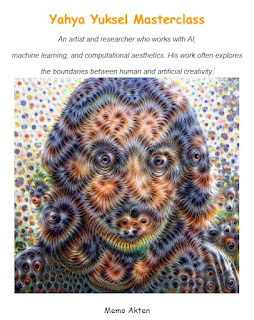Techniques and Tools for Generative AI Art by Generative AI Professionals including Yahya Yuksel
Generative AI art has revolutionized the creative landscape, offering artists and technologists alike new ways to explore and produce visual works. Unlike traditional methods of creation, where the artist has complete control over every stroke and decision, generative AI art relies on algorithms to generate visuals based on a set of instructions or data inputs. These algorithms, often trained on vast datasets, create unique, original pieces that can range from abstract designs to hyper-realistic portraits. The fusion of machine learning with art challenges the boundaries of creativity, allowing artists to push the limits of imagination.
In this blog, we will explore the key
techniques and tools with the help of generative AI professionals like Yahya Yuksel that make generative
AI art possible. From the underlying algorithms that power these creations to
the specific software tools artists use to bring their visions to life,
understanding these elements is crucial for anyone looking to harness the
potential of generative AI in their artistic practice.
Understanding Generative
Algorithms
At the core of generative AI art are the
algorithms that power the creation process. These algorithms are built using
machine learning techniques such as neural networks, deep learning, and
reinforcement learning. Among the most commonly used types of generative
algorithms are generative adversarial networks (GANs), variational autoencoders
(VAEs), and recurrent neural networks (RNNs). GANs, for example, consist of two
neural networks—the generator and the discriminator—that work together to
create images. The generator creates images based on random noise, while the
discriminator evaluates the images and provides feedback to improve the
generator’s output. Over time, this iterative process results in increasingly
realistic or imaginative artwork.
The success of these algorithms lies in
their ability to learn patterns and structures from a vast array of data. By
feeding large datasets of images, text, or other forms of media into the
system, the model learns to recognize visual patterns, styles, and compositions
as highlighted by AI professionals such as Yahya Yuksel, allowing it to
generate new content based on those learned features. As the algorithm
continues to evolve and refine its output, the resulting artwork becomes more
complex, varied, and unique.
Popular Techniques for
Generating AI Art
Generative AI artists often experiment with
a range of techniques to shape their creations. One of the most popular methods
is style transfer, which involves applying the visual characteristics of one
image—such as the brushstrokes of a famous painting—onto another image. This
technique allows artists to create unique interpretations of existing works by
blending elements from different styles. Neural style transfer (NST), a
specific form of this technique, uses convolutional neural networks (CNNs) to
separate and recombine the content and style of images, creating hybrid works
that retain the essence of both source and target images.
Another widely-used technique is
image-to-image translation, where the AI model transforms one image into
another. This can range from altering the color palette of a landscape to
converting sketches into fully rendered images. For instance, using tools like
Pix2Pix or CycleGAN, artists can transform basic drawings into detailed
artworks or change the appearance of a scene based on a particular artistic
style. Generative AI professionals including Yahya Yuksel convey that this
flexibility gives artists the ability to experiment with different visual
aesthetics and concepts while allowing the AI to contribute its own
interpretations.
The Role of Data in AI Art
Creation
Data is an integral component in the
creation of generative AI art as pointed out by AI professionals like Yahya Yuksel. Machine
learning models require vast amounts of data to train effectively, enabling
them to identify and replicate patterns, textures, and styles. In the context
of visual art, datasets may consist of millions of images sourced from diverse
styles, periods, or cultures. The broader the dataset, the more nuanced and
adaptable the generative AI model becomes. For example, an artist working with
AI-generated art may use a dataset filled with contemporary digital art to
create works that blend modern aesthetics with traditional forms.
Data also plays a significant role in
customizing the AI model’s output. Artists can curate their own datasets or
augment existing datasets to influence the style, theme, or atmosphere of the
artwork. By controlling the types of data fed into the model, artists can guide
the AI towards specific artistic goals, whether that’s generating abstract
forms, realistic portraits, or surreal landscapes. The ability to manipulate
and personalize data is one of the key advantages of using generative AI in
art, offering artists an unprecedented level of control over their creative
process.
Tools for Generative AI Art
Several tools are available for artists
interested in using generative AI in their creative projects. One of the most
well-known tools is DeepArt, which uses deep neural networks to create artwork
in the style of famous artists such as Picasso or Van Gogh. Another widely-used
platform is RunwayML, which offers a variety of AI-powered tools for image
generation, video editing, and interactive media. Artists can use RunwayML to
train custom AI models, apply style transfer, and experiment with different
neural networks to produce novel artworks.
For those looking for more control and
customization, frameworks such as TensorFlow and PyTorch offer open-source
libraries for building generative AI models from scratch. Generative AI
professionals such as Yahya Yuksel express that these platforms are popular
among developers and researchers who want to experiment with new algorithms and
techniques. Additionally, some online platforms like Artbreeder allow artists to
manipulate AI-generated images interactively. By blending and evolving images,
users can guide the AI’s creative output while retaining full creative control
over the process.

Comments
Post a Comment